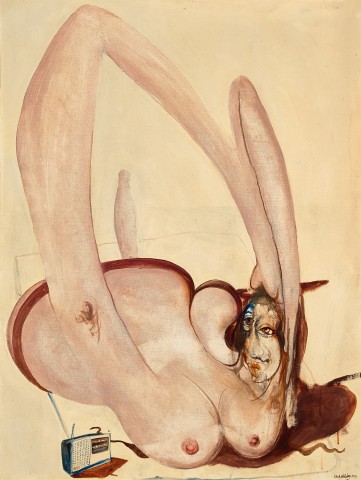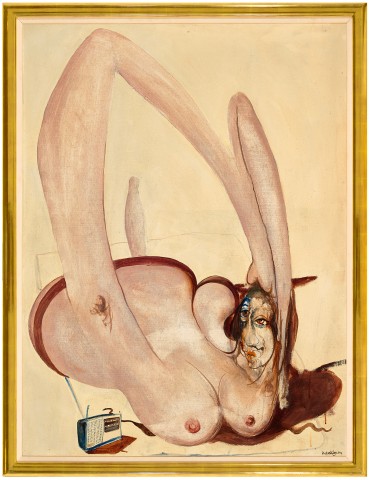BATHER ON THE SAND, 1975 – 76
BRETT WHITELEY
oil on canvas
122.0 x 90.0 cm
signed and dated lower right: brett whiteley 75–76
Australian Galleries, Melbourne
Private collection, Melbourne, acquired from the above in September 1976
Australian Galleries, Melbourne
Private collection, Melbourne, acquired from the above in November 1984
Recent Interiors, Still Lifes, Windowscapes, Sculptures and Ceramics, Australian Galleries, Melbourne, 21 September – 5 October 1976, cat. 30 (label attached verso)
Brett Whiteley: Recent Nudes, the artist's studio, Sydney, 3 – 31 October 1981, cat. 44 (illus. in exhibition catalogue)
An Exhibition by Brett Whiteley - Eden and Eve, Australian Galleries, Melbourne, 12 – 28 July 1984, cat. 33 (illus. in exhibition catalogue)
On long term loan to Bendigo Art Gallery, Victoria, December 2005 - March 2024
McGrath, S., Brett Whiteley, Bay Books, Sydney, 1979, p. 73 (illus.)
Pearce, B., Brett Whiteley: Art and Life, Art Gallery of New South Wales, Sydney, 1995, pl. 64 (illus.), p. 230
Sutherland, K., Brett Whiteley: Catalogue Raisonné, Schwartz Publishing, Melbourne, 2020, cat. 209.75, vol. 3, p. 320 (illus.), vol. 7, p. 348
Justine, Bondi, 1986, oil, charcoal and collage on plywood, 152.3 x 122.0 cm, private collection, Melbourne, illus. in Sutherland, K., op. cit., cat. 74.86, vol. 4, p. 343
After the Swim, Tangier, 1986 – 87, oil, ink, glass eye, sunglasses and cotton t-shirt on board, 152.0 x 122.0 cm, private collection, Sydney, illus. in Sutherland, K., op. cit., cat. 75.86, vol. 4, p. 345
Preliminary sketch for ‘Bather on the Sand’, 1975 – 76, pencil and ink on paper, illus. in McGrath, S., op cit., p. 72
Bather #2.jpg
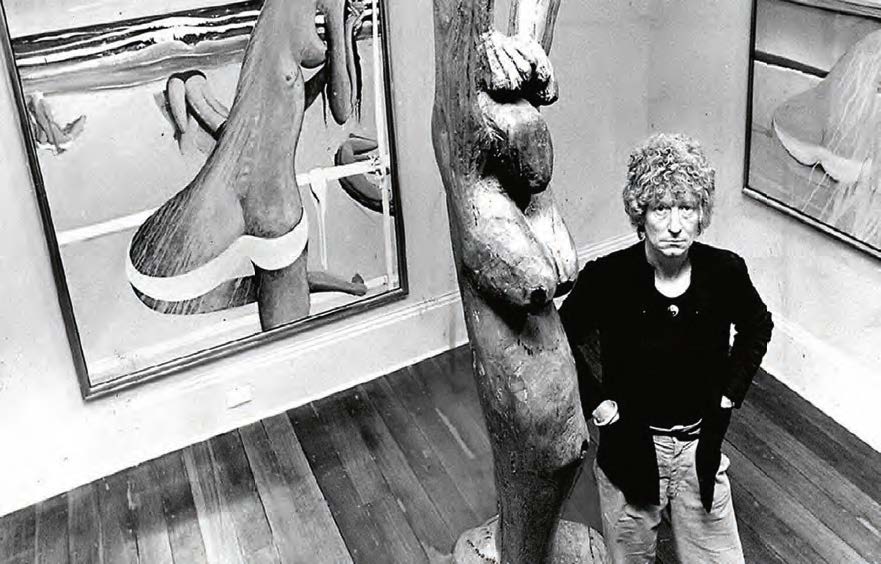
Brett Whiteley in his studio, 1955
photographer unknown
Courtesy Mosman Daily, Sydney
A celebration of the female nude, established canon of Western art history, became one of the most fertile themes within Brett Whiteley’s oeuvre. Catalysed by his semi-abstract ‘Bathroom’ nudes of 1960s London, Whiteley pursued this theme through various media in the 1970s and 1980s, in the form of totemic wooden carvings and languorous sexually charged paintings and drawings of sun-kissed antipodean shores. Looking to the guiding figures of modernist masters Henri Matisse, Pablo Picasso and Francis Bacon, Whiteley considered the nude to be an integral theme within his work. He wrote in the catalogue foreword for a 1981 exhibition devoted entirely recent works of this subject, in which featured Bather on the Sand, 1975 – 76: ‘if genius is the atheist’s word for God… then to attempt to visualise the great nude would be the highest point of creation, for perfection is impossible and no distortion can be extreme enough.’1
Painting Australia’s glittering, busy shore with the ceaseless wonderment of a returned (libidinous) expatriate, Whiteley has rightly since been celebrated as the ‘great Australian painter of female sexuality at the beach’.2 The Whiteleys were seasoned travellers, and throughout the 1960s they had lived in and visited dozens of cities throughout Europe, Africa, Asia, the Middle East and America. Bather on the Sand, 1975 – 76 was Whiteley’s first major painting of bathers by the sea since returning to Australia in December 1969. An iconic painting within his oeuvre, Bather on the Sand crystallised the distinctive form of the reclining bather in Whiteley’s iconography, inspired by a rapid ink sketch of Wendy at Bondi, with waves lapping in the background – (Study for ‘Bather on the Sand’), 1975 – 76, ink drawing in artist’s sketchbook. A version of this figure study appears pinned to the wall of the artist’s Lavender Bay living room within his Archibald-prize-winning Self Portrait in the studio, 1976 (Art Gallery of New South Wales), echoed by the vertical forms of his contemporaneous wood carving, Her, 1975. Perhaps by virtue of this constant visual presence in Whiteley’s working and living environment, the winged shape of the reclining bather reappears in several of his major paintings of the beach during the final decades of his life. These include the large landscape painting Balmoral, 1975 – 78, painted around the same time as Bather on the Sand, and then revisited over ten years later in Justine, Bondi, 1986 and After the Swim, Tangier, 1986 – 87 and even within his unfinished Beach Polyptych, 1984/1991 – 92 (all held in private collections).
Bather #4.jpg
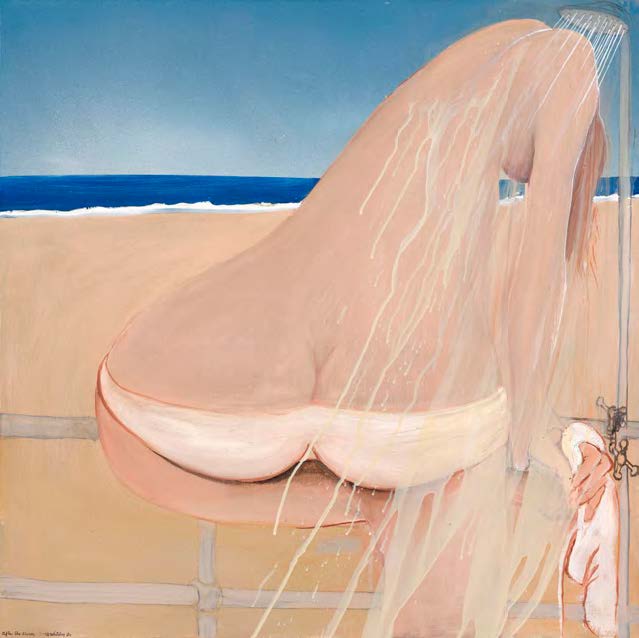
| Brett Whiteley Washing the salt off II (After the swim), 1984 oil on canvas, 86.5 x 86.5 cm National Gallery of Victoria, Melbourne © Wendy Whiteley/Copyright Agency, 2024 |
Bather #3.jpg
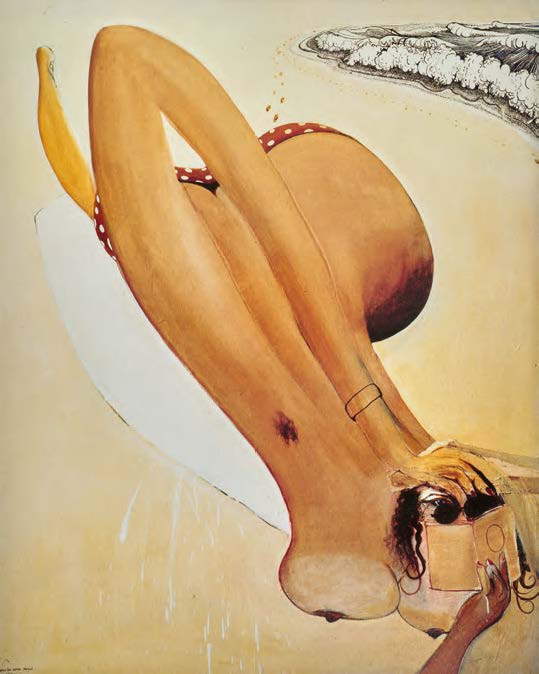
| Brett Whiteley After the Swim, 1986-87 oil, ink, glass eye, sunglasses and cotton t-shirt on board 152.0 x 122.0 cm Private collection © Wendy Whiteley/Copyright Agency, 2024 |
Stretching out on a faint small towel in a featureless vertical expanse of sand, in the bleaching light of noonday, this buxom bather could be enjoying any stretch of Australian shoreline. Amongst its related paintings, Bather on the Sand, as the title would suggest, is uniquely devoid of even the slightest sliver of blue sea or rolling waves to orientate the viewer. Having recently completed an entire suite of detailed Wave paintings, Whiteley likely appreciated the stark graphic emphasis on his nude. Her body dominates the canvas, intimately observed in Whiteley’s compressed pictorial space. Although this painting is geographically unspecific, its preliminary sketch appeared in the artist’s notebook amongst sketches of lounging and frolicking bathers at Bondi, which Whiteley had been refining into a busy landscape painting (never realised) titled ‘The Beach’ Revisited. Referring to his 1965 – 66 Pop collage masterpiece painted during a brief Australian sojourn at Whale Beach, The Beach, these sketches continued Whiteley’s hedonistic beach voyeurism and provided source material small group of closely connected paintings developing what Kathie Sutherland qualified as ‘the possibilities of distortion and exaggeration.’3 The restricted chromatic palette of honey tones and stark composition of Bather on the Sand highlight this plastic manipulation of Whiteley’s figure, turning her into a Matissian arabesque of intertwined limbs.
Brett Whiteley’s nudes all find their genesis in the early ‘Bathroom’ nudes of Wendy created in London between 1962 – 64, whose tender, tense and ambiguous forms were immediately compared to the works of Pierre Bonnard and Francis Bacon.4 Although Whiteley had met the latter, a titan of London’s art scene, while living there in the early 1960s, his influence would become much more dominant in his next series of nudes, the tortured Christie paintings (1964 – 65). Whiteley’s interaction with Bacon continued even when he had moved back to Australia, through to the mid-1980s when he painted Bacon’s portrait for the Archibald Prize (twice, in 1984 and 1989). Whiteley clarified Bacon’s influence on his nascent figurative works: ‘I wasn’t absorbed at all by Bacon but coming back into figuration, I could see that he had arrived at devices of expression, especially with the face, that if one was going to paint figuratively, there was no way one couldn’t use some of these discoveries.’5
Bather #5.jpg
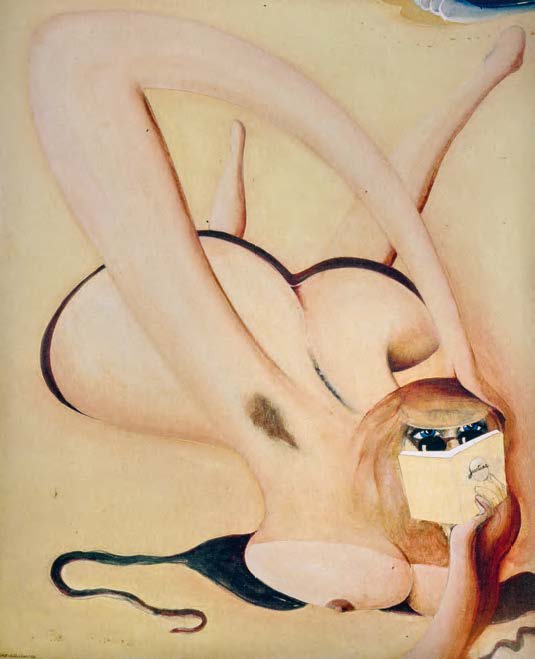
| Brett Whiteley Justine, Bondi, 1986 oil, charcoal and collage on plywood 152.3 x 122.0 cm Private collection © Wendy Whiteley/Copyright Agency, 2024 |
Whiteley’s bather lies on her belly, although instead of reclining horizontally like a romantic odalisque she faces the viewer, staring with wide eyes ringed with large lashes. Reprising a vulnerable and joyful pose with bent elbows raised frequent in Henri Matisse’s works, cited by Pablo Picasso the following year in the iconic Demoiselles d’Avignon, 1907, the sweeping loops of her elongated arms draw attention to her foreshortened Baconian face. The distorted Janus-face of Whiteley’s ink sketches is repeated here in paint, with aquiline profile and frontal views combined with a startling dash of ultramarine blue around her left eye. The bather’s gaze appears unabashed, meeting the artist’s eye with alluring defiance and pouting red lips. She is enjoying and inviting his looming voyeurism. The rhythmic loops of her arms are mirrored by the emphatic arches of her breasts in the foreground (her bikini-top lying open underneath her) and her fleshy derrière, which expands voluptuously through the centre of this painting. It is easy to imagine Whiteley delighting in and emphasising these hilly contours, stretching his own arms across the large canvas to trace the distinctive outline of his subject’s curves.
Bather on the Sand reprises Whiteley’s preferred motif of the bather stretching, arms held aloft in a double-arched shape, first explored after observing his wife’s toilette, washing her hair with a hand-held showerhead (Wendy Under the Shower, London, 1962, private collection). Whiteley was not afraid to follow in Matisse’s footsteps, enacting the same sacrifice of polished modelling in favour of ‘violent transitions and emphatic simplifications’ that Kenneth Clark identified in this predecessor’s most daring nudes.6 While Whiteley’s bathroom paintings toed the line between graphic abstraction and sensual power, their related forms in paintings of bathers by the sea were decidedly less abstract, which only heightened their overt eroticism. This is particularly true of Bather on the Sand, whose pose is boldly legible against an empty, monochrome background, creating ‘rhythmic patterns and the impression of a rocking movement on the sand.’7
Bather #6.jpg
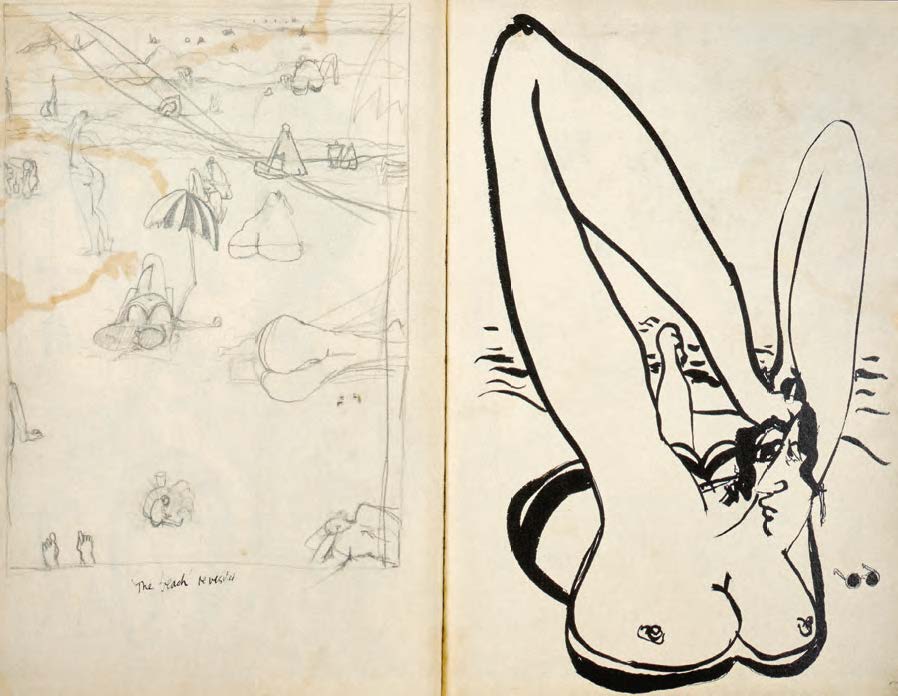
| Brett Whiteley Artist's notebook with Preliminary sketch for 'Bather on the Sand', 1975-76 pencil and ink on paper Whiteley Estate © Wendy Whiteley/Copyright Agency, 2024 |
Whiteley’s two-toned sunbather, oblivious to the dangers of overexposure, is not caught in her own reverie as are many bathers in art. In later compositions she pretends to be occupied. She reads books, coyly eyeing the artist over the top of her sunglasses and paperback. Occasionally these accoutrements provide a layer of psychological depth to the painting, weaving into the image literary themes of sexually emancipated women and complex love triangles. In Bather on the Sand, as she is in the larger landscape composition Balmoral, 1975 – 78, the figure is accompanied only by a tiny toy-like transistor radio. Brett Whiteley was fanatical about music, listening to records while he painted and often incorporating musical themes into his artworks. Here, we can only guess to what music is emanating from the portable device and colouring the bather’s playful wordless interaction with the artist. While other paintings of bathers Whiteley is self-referential, including in the composition a little mise-en-abyme of his own hand copying the scene onto clipboard (for example within the lower right-hand corners of The Beach, 1966 and Sketching at Bondi, 1986 – 87), Bather on the Sand includes no such distancing device between the artist and his observed subject. Here, Whiteley is entirely in the moment. In 1994, historian Geoffrey Dutton described Whiteley as ‘Australia’s supreme artist of the hedonism of the beach, as well as of sexual comedy [where] abandonment rules.’8
In 1974 Brett Whiteley and his wife Wendy purchased the Lavender Bay home that they had been renting since 1970. This period of settled belonging in Australia and a stable loving relationship heralded the beginning of Whiteley’s mature phase as a painter, his house’s sublime views of Sydney Harbour leading to the creation of his most celebrated works. Announcing a new aesthetic manifesto in the exhibition catalogue for his show at Australian Galleries in November 1974, Whiteley wrote: ‘The paintings in this exhibition begin from the premise of recording the glimpse seen at the highest point of affection - points of optical ecstasy, where romanticism and optimism overshadow any form of menace or foreboding.’9
As it had been briefly for the artist in 1965 at Whale Beach, the potent spectacle of sun and sand of Sydney beaches became a vessel to reimagine his relationship with the country of his birth. The artist wrote in his diary, with his distinctive stream-of-consciousness prose, of idyllic days of summer lassitude with libidinous overtones: ‘Tumbling and telescoping into days, old ways – grinning and brimming apricot hot desire on transparency blue days, of honey-legged girls and half-baked mateship warming sand to a haze. And what a haze! So gentle – delicious sunny indifference – the freedom of stupor.’10
Bather #7.jpg

| Brett Whiteley Painting Francis Bacon's Portrait at Bacon's studio, 7 Reece Mews, October 1984 photographer: John Edwards Collection & image © Hugh Lane Gallery, Dublin © The Estate of Francis Bacon |
1. Whiteley, B., ‘Recent Nudes’, exhibition catalogue, Artist’s Studio, Sydney, 1981, n.p.
2. Featherstone, D., The Beach, Australian Broadcasting Company and Featherstone Productions; Sydney, 2000
3. Sutherland, K., ‘Essay: The Nude: the Bathroom, the Bedroom and the Beach’, in her Brett Whiteley: Catalogue Raisonné, Schwartz Publishing, Melbourne, 2020, vol. 7, p. 23
4. op. cit., vol. 7, p. 11
5. Brett Whiteley, cited in McGrath, S., Brett Whiteley, Bay Books, Sydney, 1979, p.58
6. Clark, K., The Nude. A Study in Ideal Form, Princeton University Press, 1990, reprinted by the Folio Society, London, 2010, p. 262
7. Sutherland, op cit. vol. 7, p. 23
8. Dutton, G., On the Beach, On the Beach, Australian Artists at the Shore, Museum of Modern Art at Heide, Bulleen, 1994, p. 17
9. Brett Whiteley, 1974, cited in McGrath, S., Brett Whiteley, Angus and Robertson, Sydney, 1992, p. 130
10. Brett Whiteley, cited in McGrath, 1979, op. cit., p. 75
LUCIE REEVES-SMITH
